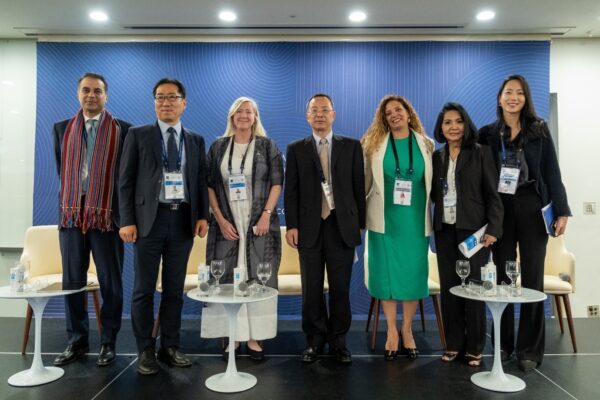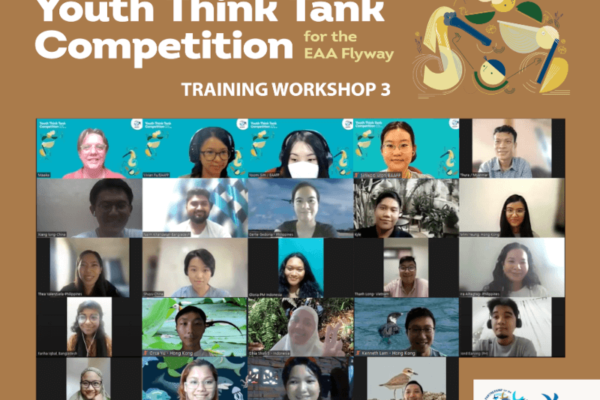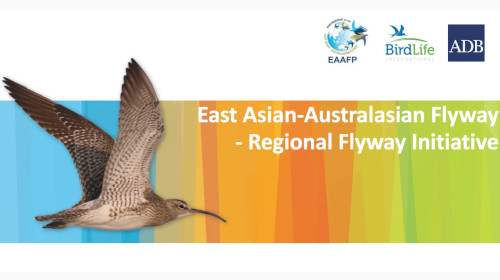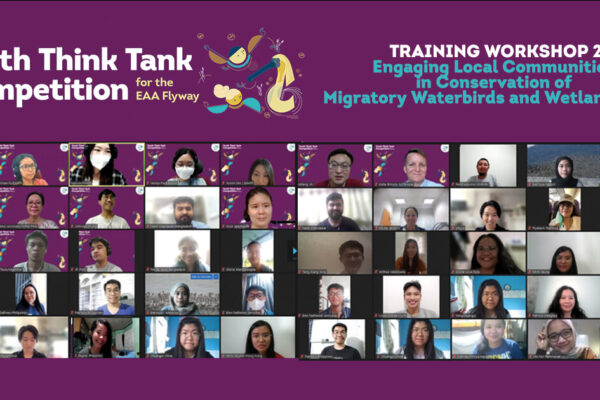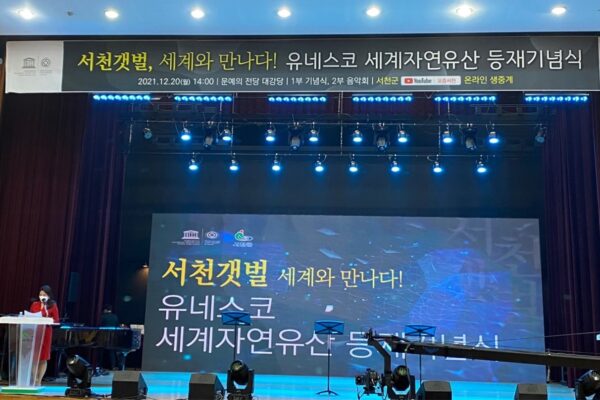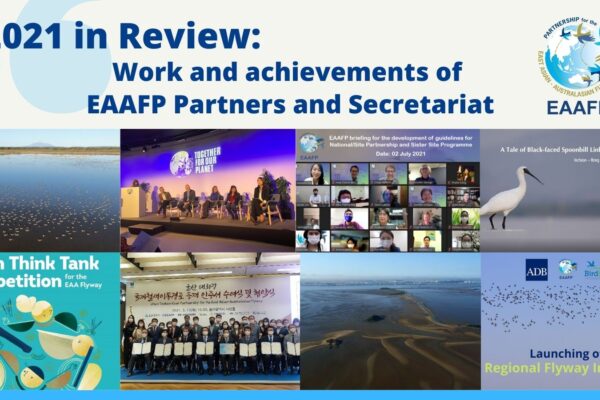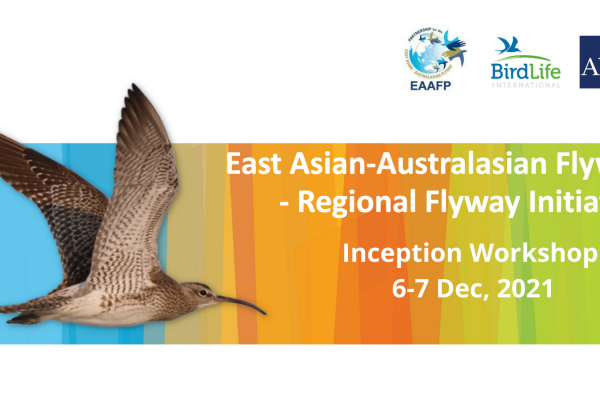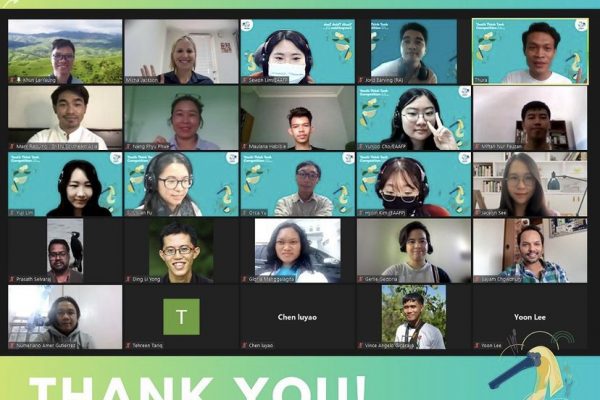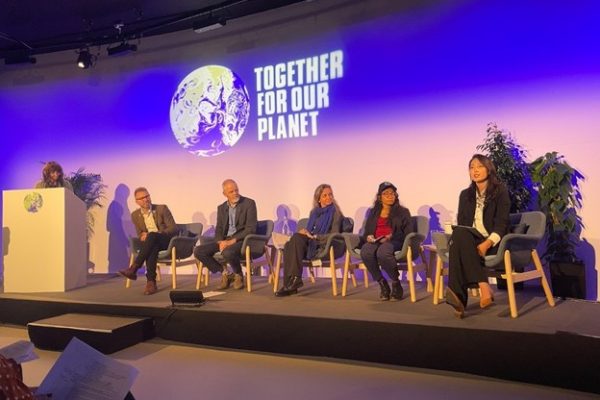-
Report on meeting of the Range States of the Central Asian Flyway
Dr. Taej Mundkur introducing EAAFP at the meeting © Hanns Seidel Foundation, Korea Between 2nd and 4th May, 2023, a Central Asian Flyway (CAF) Range States meeting was organised by the Convention on the Conservation of Migratory Species of Wild Animals (CMS) Secretariat and hosted by the Government of India with support of the Wildlife Institute of India, in New Delhi, India. The meeting was attended by 75 representatives of government and relevant organizations, aiming to discuss an institutional framework for the conservation of migratory birds and their habitats in the CAF. Dr. Taej Mundkur, attended on behalf of BirdLife International to present the CAF Situation Analysis report on migratory birds and their habitats. He also on behalf of the East Asian – Australasian Flyway Partnership (EAAFP), as Vice Chair of the Technical Sub-Committee, gave a presentation to share the case in EAAFP, of which BirdLife International and the CMS Secretariat are partners. The CAF covers 30 countries, including the breeding grounds of many birds in central and eastern Russia, Central Asia, west, central and northern China, and Mongolia. The CAF lies between the East Asian – Australasian Flyway and African Eurasian flyways. It overlaps with both, particularly in the northern and central latitudes where many of the birds breed and stage during migration. This meeting built on the history of previous meetings of the CAF range states (in Uzbekistan, 2001, India 2005, United Arab Emirates 2012, and India 2019) and follows on the decisions of the 13th meeting of the Conference of the Parties (COP13) to CMS, held in Gandhinagar, India, in 2020, to establish an institutional framework to support the implementation of conservation action for migratory birds and their habitats in the region, by CMS COP14 due in October 2023. The three-day meeting was attended by 75 representatives of governments from the following 12 countries: Armenia, Bangladesh, Kazakhstan, Kuwait, Kyrgyzstan, Mongolia, Oman, Saudi Arabia, Tajikistan, Uzbekistan, and India together with representatives of the Secretariats of CMS, the Memorandum of Understanding on the Conservation of Migratory Birds of Prey in Africa and Eurasia (Raptors MOU), the African-Eurasian Migratory Landbirds Action Plan (AEMLAP) and the East Asian – Australasian Flyway Partnership (EAAFP) and of international organisations including BirdLife International, Hanns Seidel Foundation, IUCN, WWF – India and Wetlands International - South Asia, national NGOs including Bombay Natural History Society, senior representatives of the forest department of different states of India, national organisations and others. The meeting discussed ways to promote international cooperation between range states to conserve and reverse the decline of nearly 600 species of migratory birds of over 80 families, including waterbirds (e.g. cranes, ducks, geese swans, pelican, shorebirds, gulls, terns), birds of prey (e.g. eagles, vultures, falcons), bustards and other land birds and seabirds that migrate and depend on a variety of habitats within the CAF. There was broad recognition of work in these countries on a number of species and habitats including research, monitoring, conservation, and restoration, capacity building, and awareness-raising, involving citizen science, researchers, conservationists, NGOs, local grass-roots organisations, and the corporate sector, in addition to by national and local government agencies and inter-government frameworks. Dr. Taej Mundkur presenting about the EAAFP at the meeting ©Mohamed Shobrak The main outcomes of the meeting were to: Discuss and agree on an institutional framework for the CAF for all migratory birds through the establishment of a CAF Initiative, under the umbrella of the CMS and with the support of the Government of India, that will include governments, MEAs, international organisations, international NGOs and other stakeholders. Consider options for a CMS CAF coordination unit to be hosted by India in coordination with the CMS Secretariat. Draw conclusions from a draft comprehensive CAF Situation Analysis report presented by BirdLife International and discuss priority areas for implementation. The report highlights the degradation and loss of all habitats and direct threats to birds including increasing collision and electrocution from power lines and other energy and linear infrastructure, and illegal killing, and poisoning across the flyway. The meeting agreed to contribute to the finalization of the report by providing feedback by the end of May to meet the aim of making the final report available at the CMS COP14 in Uzbekistan in October 2023. Develop and agree on a draft roadmap for updating the CMS CAF Programme of Work and Action Plan. Develop and agree on a draft CMS Resolution text, and the Terms of Reference for the new Initiative, as well as CMS Decisions outlining the next steps in the development of the initiative. These documents would be proposed for consideration and adoption to the CMS COP14 in Samarkand, Uzbekistan (Oct 2023). The new CAF Initiative will recognize, support, and strengthen regional and national implementation of existing international frameworks (incl. AEWA, Raptors MOU, AEMLAP, CAF Waterbird Action Plan, and EAAFP ) in the CAF region. The initiative will also undertake a range of actions, funding permitted, as per a Programme of Work and Action Plan to be developed in the future to conserve migratory birds and their habitats. The meeting called for the first meeting of the CAF initiative to be organised in 2024 to progress the establishment of the coordination mechanism and confirm modalities for operations of the initiative and priority collaborative actions. Outcome documents of the meeting and all presentations are now available at the CAF Meeting website: https://www.cms.int/en/meeting/meeting-range-states-central-asian-flyway Prepared by Taej Mundkur, Good Earth Environmental
Continue reading -
EAAFP engagement at the ADB 56th Annual Meeting of the Board of Governors
Panel Discussion at the side event “The Steps for Making the Regional Flyway Initiative a Reality” ⓒ EAAFP Secretariat The 56th Annual Meeting of the Board of Governors of Asian Development Bank (ADB), hosted by the Ministry of Economy and Finance of the Republic of Korea, was held in Songdo, Incheon, Republic of Korea, from 2nd to 5th May 2023. The theme of the 56th ADB Annual Meeting is “Rebounding Asia: Recover, Reconnect, and Reform”. About 5,000 people, including finance ministers and central bank governors from ADB members, and representatives from the government and private sectors, local and international organizations, and the press participated in meetings, seminars, and side events to discuss various topics regarding development in Asia. A side event on the Regional Flyway Initiative, co-organized by ADB, BirdLife International and EAAFP was held on 2nd May. Regional Flyway Initiative Side event During the side event entitled “The Steps for Making the Regional Flyway Initiative a Reality” (link) held on 2nd May, panelists discussed the ongoing process since the launch of the RFI and to underline actions needed to facilitate its progress from the development phase into the implementation phase. ⓒ Asian Development Bank The event was moderated by Ms. Patricia Zurita, Chief Executive Officer of BirdLife International. Ambassador Chantale Yok-Min Wong, (United States Ambassador toADB) gave an opening remark emphasizing the need for the long-term commitment and cooperation between ADB and the US. Following was the panel discussion. Our Senior Programme Officer, Ms. Hyeseon Do, participated as a panelist, together with Mr. Weihua Liu (People’s Republic of China Executive Director, ADB), Ahmed Saeed (Vice-President for East Asia, Southeast Asia, and the Pacific, ADB) Ms. Elisea G. Gozun (Chair of Compliance Review Panel, ADB) to discuss how to make the RFI feasible. They all highlighted that the national/international cooperation among people including ADB Board members and organizations, as well as wetlands conservation, is crucial to successfully implement the RFI. After the discussion, Mr. Jae Young Shin, Director of the Maritime Policy Office, Maritime Ecology Division of the Ministry of Oceans and Fisheries, Republic of Korea, gave a message of future support by highlighting future conservation cooperation between the ADB and Ministry of Oceans and Fisheries and Ms. Dawn Bennet, Ambassador to Republic of Korea, New Zealand Government, delivered a closing remarks to encourage transboundary conservation efforts. Engaging at ADB 56th Annual Meeting events The EAAFP staff participated in several side events and seminars, such as a program called “Civic Engagement and Multi-Stakeholder Partnership for SDGs in Asia”, a side event called “Digital, Climate, and Resilience”, “The Green Transition, Needs a Green Workforce: The Role of Skills Development for a Just Transition”, etc. From the side events, a key lesson learned was that the engagement of multi stakeholders including civil society and youths is crucial to the implementation of projects related to SDGs. In line with the EAAFP’s mission, cooperation among various sectors is highly significant to conservation activities. One of the key agendas discussed during side events was the role of climate finance in the funding of projects and initiatives related to climate change mitigation. They provided information regarding future investments as well as how organizations may access these funds. This knowledge may prove valuable if the EAAFP or its Partners were to seek funding for projects in the future. A booth of the Regional Flyway Initiative (RFI) and the Jiangsu Yancheng Wetlands Protection Project prepared by the ADB-PRC Regional Knowledge Sharing Initiative (RKSI) was presented. The booth also had a virtual reality (VR) activity where with the VR headset people can look around several Flyway Network Sites and tablets where people could scan each picture on the booth wall regarding the investment in the RFI, RFI areas, and Asia and the Pacific’s climate risk, and receive information relevant to the picture. The tablets also showed a map of migratory birds’ flyways and the information about each site so people visiting the booth could learn about the importance of conservation of migratory birds and their habitats. The EAAFP staff also visited several other booths form the Incheon City, various corporates and organizations where people could do various activities, participated in the activities to introduce the EAAFP and RFI, and learn about the other institutions’ work. Booth at the meeting ⓒ EAAFP Secretariat EAAFP Secretariat also contributed to a 1-minute interview video with ADB to promote the RFI (Twitter, Instagram). Ms. Hyeseon Do mentioned that we should take immediate action to conserve migratory waterbirds and their habitats, to fight against ecosystem degradation by humans and mitigate climate change. Also, together with ADB and Birdlife International, EAAFP will try to develop the RFI and scale up nature-based solutions to combat environmental challenges by conserving the wetlands in the East Asian-Australasian Flyway. ⓒ EAAFP Secretariat Guided by staff from the Secretariat before the meeting, the RFI organizers team from BirdLife International and ADB visited several migratory birds’ habitats in Incheon, such as Songdo Flyway Network Site and Ramsar Site, Ganghwa Island, and Namdong Reservoir (breeding site for Black-faced Spoonbill) and Sorae Wetland Park. Ms. Patricia Zurita (CEO), Mr. Vinayagan Dharmarajah (Regional Director for Asia), Mr. Gary Allport (Senior Adviser to the CEO) from BirdLife International, and Mr. Duncan Lang (Senior Environment Specialist) from ADB visited the EAAFP Secretariat after the RFI side event on the 2nd May. Group photo with Ms. Patricia Zurita, Mr. Vinayagan Dharmarajah, Mr. Gary Allport from BirdLife International, and Mr. Duncan Lang from ADB visited EAAFP Secretariat © EAAFP Secretariat Left to right: Mr. Duncan Lang and Mr. Warren Evans from Mr. Gary Allport © EAAFP Secretariat About Regional Flyway Initiative Launched in October 2021 at the 15th Conference of Parties to the Convention on Biological Diversity (CBD COP15), Regional Flyway Initiative (RFI) is a large-scale long-term financing initiative by the ADB, EAAFP, and BirdLife International to support the conservation, restoration, and efficient management of wetlands in the EAA Flyway. A partnership of multiple stakeholders will collaborate to develop the RFI program, scaling up the Flyway-wide conservation efforts to protect wetlands and the migratory waterbirds and the lives of the people who are dependent on them. The initiative aim to build and protect an ecological network of at least 50 priority sites over the next 10 years. For more information on RFI, click here.
Continue reading -
Youth Think Tank Competition for EAA Flyway – 3rd Training Workshop focusing on Project Management
On 6th – 7th August 2022, the Youth Think Tank Competition for the East-Asian Australasian Flyway (EAAF) had its 3rd training workshop aimed…
Continue reading -
Official Launching of the Regional Flyways Initiative Webpage
The EAAFP Secretariat is pleased to announce the release of a webpage built up for the Regional Flyway Initiative (RFI). The page was set up to archive RFI-related documents, articles, media, and events for information sharing. A brief introduction of RFI, key documents (RFI Technical Assistance Report and EAAFP Strategic Plan 2019-2028), a list of meetings and webinars, articles, and publications linked to RFI are also available. Link: https://www.eaaflyway.net/regional-flyway-initiative/ The Regional Flyway Initiative was launched in October 2021 by joint efforts with Asian Development Bank, EAAFP, and BirdLife International at the Ecological Civilization Forum of the 15th Conference of Parties to the Convention on Biological Diversity (CBD COP15). The Regional Flyway Initiative seeks to develop a long-term financing program to protect and restore EAAF wetland ecosystems and the services they provide. RFI aims to mobilize large-scale financing to support the protection, maintenance, and restoration of wetlands in East and Southeast Asia, especially coastal wetlands. The initiative aims to strengthen the conservation and sustainable use of wetlands across the region, which are crucial for the livelihoods of hundreds of millions of people and the migratory waterbirds in Asia and the Pacific. This will be achieved through partnerships among governments, non-government organizations, local communities, regional organizations, development agencies, private sectors, and other stakeholders.
Continue reading -
Youth Think Tank Competition for EAA Flyway – 2nd Training workshop
On 28th - 29th May, the Youth Think Tank Competition in the East Asian-Australasian Flyway (EAAF) engaged youth participants with a webinar and in-depth training workshop on Engaging Local Communities in Conservation of Migratory Waterbirds and Wetlands. One in a series of workshops that aims to build capacity for young conservationists on wetland and migratory waterbirds conservation in the flyway across various disciplines, the 2-day virtual workshop was organized by the EAAF Partnership Secretariat with the help of the youth organizing team. More than 100 youth actively participated in the discussions and workshops. Day 1 The workshop opened on 28th May 2022 with a webinar, “Understanding Nature-based Solutions and Local Community Engagement in Conservation of Migratory Waterbirds and Wetlands.” The 1-hour webinar focused on presentations from speakers, Ms. Kathryn Bimson, Programme Officer for IUCN Regional Asia Office, and Mr. Jiefeng Jin, Conservation Officer for the International Crane Foundation. The first presentation, given by Ms. Kathryn Bimson, was an introductory presentation on Nature-based solutions and was followed by an introductory presentation on Engaging local community in conservation by Mr. Jiefeng Jin. Both presentations helped participants ease their way into the topic and the in-depth training workshop, “Engaging Local Communities in Conservation of Migratory Waterbirds and Wetlands” that came afterwards. [PPT Materials] Introduction to Nature-based Solutions (link) / Introduction to Engaging Local Community in Conservation (link) The in-depth workshop was led by Ms. Mercy Kariuki, Programme Officer (Local Engagement and Empowerment Programme) from BirdLife International and focused on “Engaging Local Communities in Conservation of Migratory Waterbirds and Wetlands”. She emphasized the significance of Free, Prior and Informed Consent (FPIC) in the process of conservation and how the work is increasingly adopting a human rights-based approach. To delve further into the topic, the presentation was followed by a case study by Mr. George Ndung’u Muigai, Founder of the Cranes Conservation Volunteers, on the conservation of Cranes in Kenya. During his presentation, Mr. Muigai shared on-the-ground experiences engaging with the community and exchanged practical advice with the youth participants. [PPT Materials] Engaging Local Communities in Conservation of Migratory Waterbirds and Wetlands (link) / Conservation of Cranes in Kenya (link) The breakout session, participants discussed the positive and negative relations between conservation and people, so that they could learn to think in different perspectives – from local communities to conservation. The participants shared actual experiences from their respective regions and project implementations. Day 2 The in-depth workshop continued on 29th May with a short summary presentation from Ms. Mercy Kariuki before delving into a case study from Amy M. Lecciones, Executive Director of the Society for the Conservation of Philippine Wetlands, Inc who tackled Empowering Communities for Managing Agricultural Wetlands. In her presentation, Amy shared the case in Paligui Wetlands (a part of the greater key biodiversity area of Candaba Wetlands) of how local farmers were trained to be local eco-tour guides. Amy enumerated some key activities for community engagement and social challenges with the proposed conservation measures taken in Paligui. (PPT Materials) Following next was a case on Hong Kong Fishpond Conservation Scheme presented by Mr. Johnson Chung of The Hong Kong Bird Watching Society. Mr. Johnson shared how local fishermen helped to enhance the biodiversity of fishponds within the Ramsar Site and being an important player in the conservation project. Johnson shared different ways to motivate the local communities as well as the general public to support the management agreements. The outputs were beyond conserving migratory birds but also benefitted local fishermen while maintaining traditions and cultures in Hong Kong. (PPT Materials) The last case study was presented by Professor Wataru Kitamura of Tokyo City University on the Little Tern project. He shared how the once-disappeared population of Little Tern was brought back to the urban areas in Tokyo Bay area. The project demonstrated the success and need for a strong scientific base, and how it can be developed into a good citizen science programme to engage the locals and general public garner their support. It was also an innovative solution to create habitats for the birds with the use of the rooftops of building in the middle of the city. (PPT Materials) After that, the participants broke out into groups to practice stakeholder analysis of the different case studies that were presented. Youth participants shared their perspectives on identifying stakeholders and ideas on engaging them with participatory conservation objectives. [Webinar] Understanding Nature-based Solution and Local Community Engagement in Conservation of Migratory Waterbirds and Wetlands [In depth Workshop] Engaging Local Communities in Conservation of Migratory Waterbirds and Wetlands: Session 1 [In depth Workshop] Engaging Local Communities in Conservation of Migratory Waterbirds and Wetlands: Session 2 Evaluation: All 20 participants had an increase in learning for the topic of nature-based solutions. In the pre-workshop survey, half of the participants responded that they had some familiarity with the topic. In the post-workshop survey, however, 90% responded they were now familiar or ‘ready to go pro’ with nature-based solutions. All participants were satisfied and found what they learned during the workshop useful in their volunteer/work. Participants rated these three components with the highest scores: 1) trainers and speakers of the workshop (4.5/5); 2) case study presentations (4.5/5); 3) contents of the workshop (4.5/5). The most valuable learnings/ takeaways for the participants were: 1) Free, Prior and Informed Consent, 2) Stakeholder mapping and analysis and 3) Nature-based Solutions. Takeaways: Participants wrote that most valuable learnings/ takeaways for the workshop was: 1) Free, Prior and Informed Consent, 2) Stakeholder mapping and analysis and 3) Nature-based Solutions. In the words of the Flyway youth: “What really stayed in my head and in my notes also is the quote "Recognizing diversity and engaging stakeholders helps in building legitimacy, developing innovative solutions, enhancing transparency, and most importantly, in upholding social equity." “It is evident that we are currently experiencing biodiversity loss. Hence, it is a must to take action. However, there are various factors that we need to consider first. For example, the effects of the conservation programs that we want to implement on the local communities and vice versa. As conservationists, we should understand the social contexts. A way for us to plan everything is to create a stakeholder analysis. It is a process for us to be able to map and identify the target people before the project begins. Acknowledgment The Youth Think Tank Competition for the EAA Flyway Organizing Team acknowledges the great contribution from the speakers and trainers: Mercy Kariuki, George Ndung’u Muigai, Amy M. Lecciones, Johnson Chung, and Wataru Kitamura, as well the youth organizing team: Frances Alvares, Jord Earving Gadingan, Oscar Yu, Thura Soe Min Htike, Yeonju Park, Yuji Lim and Yoomi Sim. The webinar was moderated by Ms. Yoon Kyung Lee, External Relations Manager of the EAAFP Secretariat. The in-depth workshops were co-moderated by Ms. Yuji Lim, Ms. Yeonju Park, Ms. Yoomi Sim from the EAAFP Secretariat and Mr. Thura Soe Min Htike from Myanmar. Ms. Vivian Fu, Communication Officer of the EAAFP Secretariat led the coordination of the workshop. To learn more about the speakers and trainers click here. For more on the Youth Think Tank Competition click here.
Continue reading -
Seocheon City celebrated Getbol World Heritage Inscription
On 20th December 2021, Seocheon Getbol World Heritage Inscription Ceremony was held at Seocheon Arts Center to celebrate the monumental achievement of inscribing the Seocheon Tidal Flat as part…
Continue reading -
2021 in Review: Work and achievements of EAAFP Partners and Secretariat
Development of the Flyway Site Network 1. Welcome Taehwa River in Ro Korea and Sarobetsu Wetland in Japan as New Flyway Network Sites In 2021, two new Flyway Network Sites…
Continue reading -
Nature-positive Interventions in Asia’s Wetlands Pushed, More Investments on Adaptation and Resilience Crucial in Post-pandemic Growth
The wetlands in the East Asian-Australasian Flyway (EAA Flyway) provide…
Continue reading -
Youth Think Tank Competition for EAA Flyway- 1st Training workshop
The first training workshop of Youth Think Tank competition for EAA Flyway —Understanding global agenda for environment and how youth are engaged was…
Continue reading -
What COP26 brought to EAAFP
From 31 October to 12 November 2021, the United Nations Framework Convention on Climate Change (UNFCCC) 26th Conference of the Parties (COP26) was held in Glasgow, UK, co-hosted by…
Continue reading


